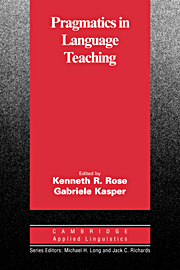Book contents
- Frontmatter
- Contents
- List of contributors
- Series editors' preface
- Preface
- Chapter 1 Pragmatics in language teaching
- I THEORETICAL AND EMPIRICAL BACKGROUND
- II ISSUES IN CLASSROOM-BASED LEARNING OF PRAGMATICS
- III THE EFFECTS OF INSTRUCTION IN PRAGMATICS
- IV THE ASSESSMENT OF PRAGMATIC ABILITY
- References
- Name index
- Subject index
I - THEORETICAL AND EMPIRICAL BACKGROUND
Published online by Cambridge University Press: 05 October 2012
- Frontmatter
- Contents
- List of contributors
- Series editors' preface
- Preface
- Chapter 1 Pragmatics in language teaching
- I THEORETICAL AND EMPIRICAL BACKGROUND
- II ISSUES IN CLASSROOM-BASED LEARNING OF PRAGMATICS
- III THE EFFECTS OF INSTRUCTION IN PRAGMATICS
- IV THE ASSESSMENT OF PRAGMATIC ABILITY
- References
- Name index
- Subject index
Summary
The chapters in Part I provide the theoretical and empirical background to the data-based studies which follow. In Chapter 2, Kathleen Bardovi-Harlig discusses how native speakers (NSs) and nonnative speakers (NNSs) differ in their use of pragmatic knowledge in production and comprehension. The production section of her chapter is organized around the four-way distinction utilized in Bardovi-Harlig (1996), namely, culture-specific speech act use, use of semantic formulas, use of linguistic devices, and utterance content. After providing ample evidence from the research literature that NNSs' understanding and use of the pragmatics of the target language often differ considerably from those of NSs, she discusses how these differences have been explained, including input factors, learner expectations, teaching materials, level of proficiency, and washback. The chapter concludes with a summary of evidence of the need for instruction, but Bardovi-Harlig is careful to note that although the evidence indicates divergence of interlanguage pragmatics from target-language pragmatic practices, such differences per se do not constitute a mandate to teach (or facilitate the acquisition of) target-language pragmatics – many other factors need to be considered in determining what, if any, areas need to be targeted for instruction, or how instruction is to be implemented.
Gabriele Kasper begins in Chapter 3 by noting that although pragmatics has played a considerable role in approaches to first and second language classroom research, classroom research has played only a minor role in interlanguage pragmatics thus far.
- Type
- Chapter
- Information
- Pragmatics in Language Teaching , pp. 11 - 12Publisher: Cambridge University PressPrint publication year: 2001

